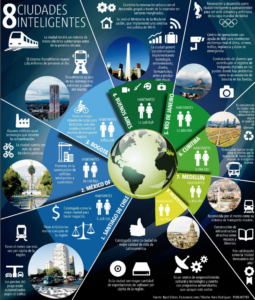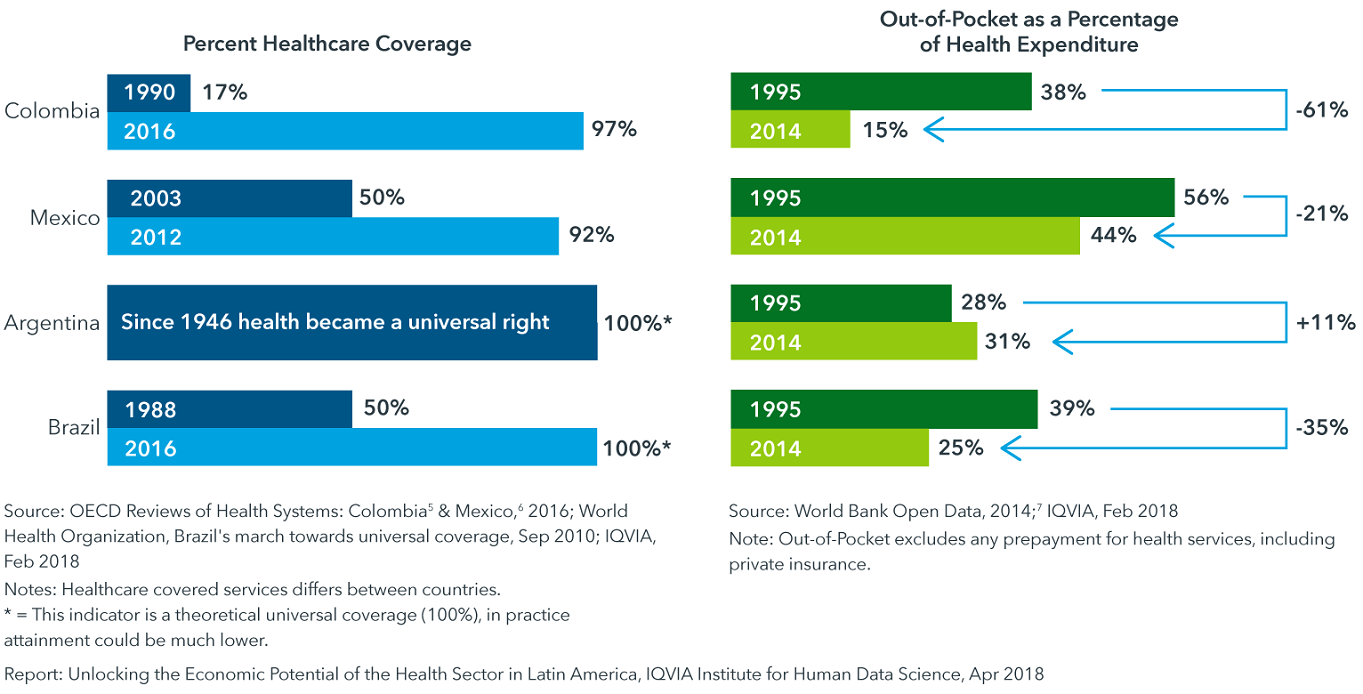The Internet of Things (IoT) is a buzzword that many people throw around but not everyone understands. While it sounds obscure, the concept is simple; IoT is communication between physical objects that connect via the Internet.
These products are implanted using sensors, monitors, and other devices that allow them to communicate with other connected devices. For example, if a machine in a factory could automatically send an alert to the supervisor’s smartphone when a gear is starting to wear down, that communication would happen through IoT.
It’s easy to imagine hundreds of applications of IoT technology that could simplify or solve everyday challenges. In Latin America, where millions of people still struggle with safety (especially in big cities), access to clean water, or adequate healthcare, the Internet of Things has the potential to provide innovative solutions to these problems.
The field is still in its infancy in Latin America. Since IoT has applications across almost every industry, efforts to join forces or create collaborative solutions have been few and far between. However, the newness of this industry, as well as the rapidly-increasing connectedness of the Latin American population, opens many opportunities for IoT solutions to take hold in the region over the next decade.
IoT Opportunities in Latin America
More than 70% of the population in Latin America now has access to mobile phones, over half of which are smartphones. Up to 63% of Latin Americans will be able to connect to the mobile Internet by 2020. This connectivity makes it possible for most people to receive notifications from connected devices and hardware, either for work or in the home.
To date, Latin Americans still have far fewer connected devices than most North Americans, but they are even more eager to adopt IoT technology than the global population. Up to 90% of Latin American businesses surveyed by Forrester Consulting were interested in exploring IoT solutions, compared to 80% worldwide.
Combine that fact with an average of just two connected devices per Latin American, versus 11.5 in the US, and it is clear that there is a massive opportunity for people innovating in IoT in the region. MicroMarket Monitor predicts that Latin America’s IoT market will be worth up to US$44.4B by 2019 if it continues to grow at the current rate.
Almost every industry could use some type of IoT solution to streamline processes. Some of the most significant opportunities are in sectors where Latin American countries have a competitive advantage, such as agriculture and mining, or in the improvement of citizens’ lives through smart cities and healthcare. Entrepreneurs across the region are already building IoT solutions to help their local communities and have recently received international attention.
Here are three areas where the IoT is improving lives across Latin America.
1. Making agriculture smarter
Sustainable, productive agriculture is a science. For commercial producers, agricultural yield – and therefore income – depends on a complex series of controllable inputs and external factors.
However, in emerging markets, many of these processes are still manual. For example, farmers that irrigate their fields with a fixed amount of water might not be maximizing their productivity because the plants’ needs change based on weather conditions. Applications for the IoT in agtech often use sensors to inform farmers about their crops or animals more frequently so that they can make informed decisions without necessarily introducing more labor.
Neltume is a Chilean agtech company founded by Antonio Cabreira that implements IoT solutions to help farmers manage pesticides and moth infestations in Chile and the US. Neltume builds solar-powered cameras and sensors that allow farmers to monitor their moth traps from afar, instead of visiting each one individually.
These sensors also track humidity and temperature. This solution helps farmers spray pesticides only where and when they are needed, decreasing costs for the producer and shrinking the environmental impact of farming. Having tackled Chile’s growing season, Neltume was invited to present at the Future Farm conference in the US and is using their technology to detect the moths that attack sweet corn.
Similarly, founders Alberto Vaccaro, Andrei Vazhnov, Elvio Toccalino, Sebastian Cerone, and Sebastian Marra of Argentine IoT startup, Less Industries, are helping farmers manage crops stored in silo bags using a spear that monitors heat, humidity, carbon dioxide, and movement. This sensor allows producers to make small changes in storage conditions to ensure that crops do not spoil. Less Industries also offers tools that analyze the soil, measure water levels, and track livestock, sending information directly to an intuitive dashboard on a farmer’s smartphone or computer.
Finally, this year’s Start-Up Chile Demo Day winner, Observe Technologies, founded by Hemang Rishi, monitors fish feeding using artificial intelligence to help producers save money and protect the environment by wasting less food. Observe Technologies uses sensors, cameras, and algorithms to provide farmers with constant data about their fish’s feeding habits so they can grow more efficiently.
These IoT technologies allow farmers to receive and manage more detailed information about their production, helping them make informed decisions that increase output. More importantly, anyone with a smartphone can access this information, making these solutions viable even for relatively small agriculturalists in Latin America.
2. Making cities smarter and safer
Currently, many of Latin America’s cities are failing their citizens. Although they will create over 65% of the region’s GDP growth by 2025, Latin America’s 198 large cities (defined as 200k+ people) have not adapted to accommodate their growing populations.
A McKinsey study in Brazil found that the top concerns for Latin America’s city dwellers were transportation and safety, namely combatting crippling traffic and rising homicide rates in some areas. As many as 42% of Brazilians report being “very afraid” of violent crime. Unsurprisingly, many of the startups featured at the second annual IoT Latin America Conference in São Paulo focused on improving home safety.
IoT technology is offering solutions to these challenges via the development of “smart cities,” cities that use Internet and communications technologies to improve efficiency, sustainability, and safety for its citizens. McKinsey estimates that updating even just cities in Brazil with smart city technology could generate an additional US$14B for the local economy by 2025. These solutions will become all the more important over the next decade as Latin American cities will compete for workers that increasingly work for a digital economy that is not necessarily tied to a single location.
For example, Base Operations, created a connected dashboard for employers to minimize risk of employees traveling abroad. The program includes a check-in system, safe routes to destinations, and real-time notifications to help people maneuver emerging cities safely.
Cities across Latin America, including Buenos Aires, Santiago, Medellin, and São Paulo are already implementing initiatives at the public policy level that use IoT technology to make their cities smarter.
Here are a few ways Latin America’s major cities are implementing IoT technology to improve citizens’ lives:
- Santiago’s tolling systems automatically change the tariffs based on the amount of traffic on the road.
- Medellin invested over US$100M in investment to develop IoT systems that regulate traffic, reduce accidents, and speed up emergency response times.
- Buenos Aires implemented city-wide public Internet access and collaborates with citizens on IoT-based projects via a government program, Smart Lab.
- São José dos Campos, in São Paulo, created an emergency response system that automatically contacts all emergency services during a distress call, helping reduce crime rates by 20% since 2012 and helping solve more homicide cases.
Startups are also using the IoT to tackle issues in transportation safety, one of the biggest issues facing Latin American cities. Jooycar, a Magma Partners portfolio company founded by Maria Paz Gillet and Emilio Figueroa, creates small devices that plug into vehicles to monitor driving habits, traffic, and vehicle health. The device can communicate automatically with a smartphone app or platform that provides constant data that has applications for insurance or fleet management.
These public and private initiatives use connected devices to create safer and more sustainable cities across Latin America. Up to 80% of the population will live in urban areas by 2021, therefore these solutions are essential to ensure Latin America’s cities can support their inhabitants.
3. Improving healthcare outcomes
Healthcare improved dramatically over the past 20 years in Latin America. Countries such as Brazil, Colombia, Argentina, and Mexico took big steps toward providing free, universal healthcare. Even more neoliberal nations like Chile provide low-cost healthcare options for almost every citizen.
However, Latin American healthcare systems still suffer from significant challenges such as overcrowding, long wait times, and a lack of medical services in rural areas. New technologies that use monitors to measure and track patients’ health remotely are helping. IoT health-tech startups are gaining attention from international investors as they are solving global problems within the local market.
For example, Mexican startup Higia, founded by Jose Antonio Torres and Julian Rios Cantu, developed a non-invasive sensor for early breast cancer detection. The wearable device connects to a smartphone or smartwatch and monitors abnormalities in breast temperature that could be signs of breast cancer. While still in early production, Higia received US$5M from Khosla Ventures and participated in Y Combinator in late 2018. Mexican IoT startup, Sunu, which makes sensor bands for the visually impaired (now in Boston), also participated in Y Combinator in 2017.
BABYBE, a Chilean health tech startup founded by Camilo Anabalon and Raphael P. M. Lang, helps mothers connect with their premature babies through a connected mattress that mimics the mother’s breathing and heartbeat. The new BABYBE app also allows parents to send babies their heartbeats and voice messages through a smartphone or Apple Watch. This system improves health outcomes for premature babies and received international attention through a partnership with Germany’s largest health insurance company, Techniker Krankenkasse.
Spanish app, SocialDiabetes, allows diabetes patients to sync glucose monitors with their phones so they can make data driven decisions about eating and improve glucose spikes throughout the day. The app won the European Commission’s most innovative product award in 2017.
These startups are not only improving healthcare outcomes in Latin America, but they are also making an impact on a global scale. While Latin American health systems have a long way to go, IoT startups are creating innovative solutions that help citizens gain access to better care.
The future of IoT in Latin America
Latin America is becoming increasingly connected through the Internet and smartphones. This connectivity creates opportunities for continuous communication, monitoring, and data collection from almost any device that can connect to the Internet. Sigfox, the world’s largest provider of Low Power Wide Area Networks (LPWAN), is now providing coverage to over 56% of the Latin American population. These changes create unprecedented opportunities to use the IoT to solve global problems that still affect Latin America. A few other Latin American IoT startups not mentioned above include:
- Ubidots (Colombia)
- WiseHome (Brazil)
- Dojot (Brazil)
- Nextrue (Brazil)
- Chipus (Brazil)
- Tecrea (Colombia)
- Monitor (Chile)
- Zenzzer (Mexico)
- M2 Technic (Chile)
From agriculture to transportation and healthcare, the Internet of Things is just beginning to change the way Latin Americans face local challenges, leaving room for even more innovative solutions to appear in the near future.
If I missed any Latin American IoT startups to watch, please let me know in the comments!


